 |
|||||
|
|||||
| Preview of Stamps Catalogue: VOLUME 1 |
 |
|||||
|
|||||
| Preview of Stamps Catalogue: VOLUME 1 |
Return To Catalogue - France overview
Note: on my website many of the
pictures can not be seen! They are of course present in the catalogue;
contact me if you want to purchase it.
Nice website on this subject: http://www.chez.com/memorial/ani.html (now on http://www.marcophilie.org/ or http://www.marcophilie.france-timbres.net/)
The earliest cancels of France consist of a grid, six-pointed stars, etc. examples:
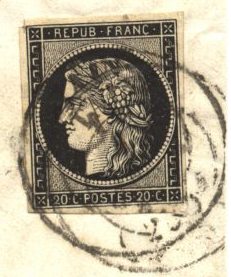

(Reduced size, departure cancel used to obliterate the stamp)
The grille cancel was ment to be the earliest cancel of France. However, this cancel was not yet ready in January 1849, when the stamps were introduced. So provisional cancels (even a Maltese cross seems to exist) and pencancels existed during this period. All these provisional marks are rare. Above a picture of a stamp with a departure cancel of Tain (diameter 25 mm). These departure cancels also exist with diameter 21 and 32 mm.

(A very rare 10 c tete-beche, image obtained from
http://www.sandafayre.com )
The above stamp is a typical example of a grille cancel. This grille cancel was used from January 1849 to January 1852 (in rare cases it was used after 1852). It is normally in black, but red and blue colours seem to exist (I have never seen them). A normal towncancel was supposed to be placed elsewhere on the letter. This cancel is found on the first Ceres stamps (but can also be found occasionally on the Napolean stamps; in 1852 in Paris, in 1860 in Bayonne, in 1853 in Angouleme and in Italy during the occupation of Rome upto 1866; these cancels are very rare).

This cancel looks like the grille cancel described above, but it is 'continuous'. Also, there are only 6 horizontal lines in this cancel (in the normal grille there are 7x7 lines forming a 6x6 lozenges pattern)



(Reduced size)
Upto about 1862 small number cancels were used. After this new numbers were attributed to the post offices and large number cancels were introduced with these new numbers.
Some numerals with their corresponding towns (small number or 'petits chiffres'), there are about 4500 different numbers. The numbers 1 to 3703 were used for post offices in France (outside of Paris). The numbers 3704 to 3709 for foreign post offices. The numbers 3710 to 3739 to the post offices in Algeria. Post offices created from 1852 to 1862 were assigned with number from 3740 to 4193. The post offices of Savoy and Nice (which belonged to Italy before) got the numbers 4194 to 4306.
1: Abbeville
209: Avignon
511: Brest
578: Caen
601: Cannes
853: Chamonix
908: Colmar
1102: Dijon
1452: Grenoble
1730: Limoges
1817: Lyon
1818: Lyon
1855: Le Mans
1896: Marseille
1977: Metz
2128: Montpellier
2199: Mulhouse
2221: Nantes
2272: Nimes
2273: Niort
2340: Orleans
2388: Pau
2652: La Reole
2746: Orsay
2807: Sarlat
3176: St.Malo
3380: Tourcoing
3383: Toulouse
3703: Yvre-l'Eveque
3710: Alger
3721: Constantine
3739: Tlemcen (Algeria)
4222: Monaco
A complete list can be found at: http://www.chez.com/memorial/ani.html. Be careful, when the large number cancels were introduced, together with a new numbering system, the small number cancels were redistrubuted as well! So the small number cancels can be found used in the town corresponding to the new numbering. On individual stamps, only the date of issue of the stamp can give information on the provenance of the cancel.
Large numbers:

"-55-" numeral cancel of Albi, note the dashes in front
and behing the number.
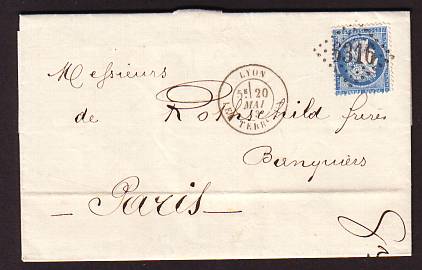
(Large number cancel '6316'; Lyon-Les-Terraux on letter)
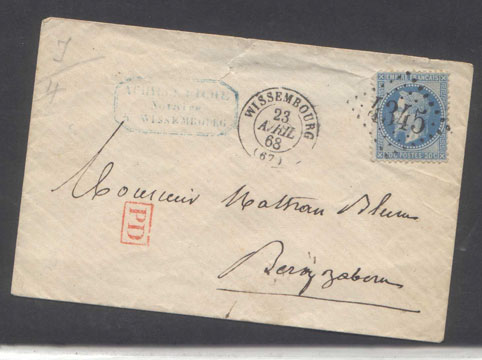
('4345' large numeral cancel 'Wissembourg' on cover)


Some numerals with their corresponding towns
(large number), there are about 6500 different large number
cancels:
1: Abbeville
55: Albi
249: Auxerre
260: Avignon
359: Bayonne
532: Bordeaux
611: Brest
691: Caen
698: Calais
720: Cannes
1002: Cherbourg
1076: Colmar
1299: Dieppe
1307: Dijon
2005: Lens
2089: Nancy
2145: Lyon (also exists with letters A..F added for suboffices)
2240: Marseille (also exists with letters A..F added for
suboffices)
2336: Metz
2387: Monaco
2502: Montpellier
2578: Mulhouse
2598: Nancy
2601: Nanterre
2602: Nantes
2610: Narbonne
2684: Niort
3103: Reims
3112: Rennes
3219: Rouen
3949: Thonon
3997: Tours
3982: Toulouse
4034: Troyes
4078: Valenciennes
5000: Aboukir (Algeria)
5005: Alger (Algeria)
5051: Oran (Algeria)
5083: Constantinopel (Turkey)
5104: Shanghai (China)
6449: Moussey (highest number)
A complete list can be found at: http://www.chez.com/memorial/ani.html The large numbers were in use up to March 1876, when they were replaced by town cancels. The numbers 1 to 99 often have a small line in front and behind the number. The order is again alphabetical, but from 4362 to 4999 were created for newly opened post offices. The numbers 5000 to 5078 were used in Algeria, 5079 to 5107 for foreign post offices. The numbers 5108 to 5169 were used for new offices in Algeria and abroad. Finally 6000 to 6449 were used for new offices in France.
Special numeral cancels used in post offices abroad on stamps of France:

(Large number cancel)
| Town: | Small number | Large number |
| Basel (Switzerland) | 3705 | 5081 |
| Galatz | 4008 | 5085 |
| Braila | 4009 | 5087 |
| Yokohama (Japan) | - | 5118 |
| Constanza | - | 5139 |
| Tripolos | - | 5264 |
| Alexandria (Egypt) | 3704 | 5080 |
| Cairo (Egypt) | - | 5119 |
| Port Said (Egypt) | - | 5129 |
| Suez (Egypt) | 3709 | 5105 |
| Shanghai (China) | 4013 (only used a very short time) |
5104 |
| Tanger (Morocco) | - | 5106 |
| Volos (Turkey) | 4019 | - |
| Alexandrette (Turkey) | 3766 | 5079 |
| Beirut (at that time in Turkey) | 3706 | 5082 |
| Constantinopel (Istanbul, Turkey) | 3707 | 5083 |
| Dardanelles | 3708 | 5084 |
| Gallipoli | 3767 | 5086 |
| Rodosto | - | 5086 |
| Ineboli | 4010 | 5088 |
| Jaffa (at that time in Turkey) | 3768 | 5089 |
| Cerasunt | 4011 | 5090 |
| Ladicte | 3769 | 5091 |
| Mersina | 3770 | 5092 |
| Mytilene | 3771 | 5093 |
| Rhodos | 3772 | 5094 |
| Salonici | 4012 | 5095 |
| Samsoun | 4013 | 5096 |
| Sinope | 4014 | 5097 |
| Smyrna | 3709 | 5098 |
| Sulima | 4015 | 5099 |
| Trebizonde | 4016 | 5100 |
| Tripolis (Syria) | 3773 | 5101 |
| Tulza (Rumania) | 4017 | 5102 |
| Varna (Bulgaria) | 4018 | 5103 |
| Enos | - | 5153 |
| Port Lagos | - | 5154 |
| Dedeagatz | - | 5155 |
| Cavalle | - | 5156 |
| Galata | - | 5243 |
Example: stamps used in Constantinopel (Turkey):



(Zoom-ins)


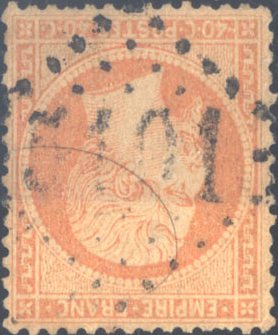
(Stamps used in Salonici, '5095', Suez, '5105' and Tripoli
'5101')

('5104': Shanghai)
In 1876 normal cancels with townname and date were used and numeral cancels were no longer used.
Special cancels (travelling railroad post office):


('PN', Paris-Nantes and 'BP1e', Bordeauz-Paris 1e cancel)

('MLSE' Marseille-Lyon)

(Reduced size, 'P LIL', Paris-Lille)

('NP' Nantes a Paris cancel on cover)
I have also seen a similar cancel with "P ORL" (Paris-Orleans). There are many more letter combinations, see for a list of all of them: http://www.chez.com/memorial/ani.html
There also exist cancels with letters in the center, examples:
They were used in Paris, the following exists: A, AS, AS2, AS3, B, BS, BS1, BS2, C, CS, CS1, CS2, CS3, C2, C3, D, DS, DS1, DS2, DS3, E, ES, ES1, ES2, F, FS, FS1, FS2, G, H, HS, HS1, HS2, HS3, HS4, J, JS, JS1, K, KS, KS1, KS2, L, M and N. Two types exist, with small letters or with larger letters (not all letters exist in all types). They were used from 1852 to 1863.
In Paris a 6-pointed star (so-called 'etoile de Paris') was used with a number in the center from 1863 to 1875. The number varies from '1' to '39'. Multiple-star cancels also seem to exist (more stars next to each other). Example of some star cancels:

(Star cancel '22' on envelope, reduced size)

('Etoile de Paris' 24, 'Rue de Clery', reduced size)
A nice website on these cancels can be found on: http://perso.wanadoo.fr/jef.estel/Sommaire.htm (in French). The most important post offices had the lowest number. First 35 numbers existed, but in 1866 5 new numbers were added. Some numbers and their post offices: 1: Place de la Bourse, 2: Rue St-Lazare (in November 1873 changed to Rue Milton), 3: Place de la Madeleine, 4: Rue d'Enghien, etc. etc. There also exist stars without any number, examples:




A similar cancel 'OL' (Origine Locale) exists (two types: with solid circle and dotted circle). The 'OR' cancel was already introduced in 1836 before stamps were issued. The 'OL' cancel was introduced in 1868 (both types) and used when the mailman collected letters during his round.
The anchor cancels were used on French paquebots. This cancel can be found also on stamps of the French Colonies. These cancels were first used in 1857, they are usually in black, but blue and red cancels seem to exist (I have never seen them).



Examples: "LE HAVRE", "MOREZ-DU-JURA" and
"TOULOUSE"


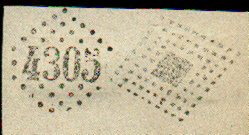

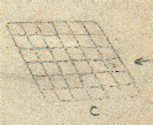



Fournier has also used other forged cancels. Fournier used these cancels on his forgeries. I don't have any further information at this moment.
During the siege of Paris by the Germans (1870), some letters were transported by a hot air balloon. They have the overprint (either manual or with a cancel): "PAR BALLON MONTE". Letters with such marks are sought after and rare. Examples:


(Images obtained from a Francois Feldman auction)
These marks were placed on letters from abroad. Example, for a letter from Switzerland (with enlarged red entrymark 'SUISSE ANNECY'):


The above French stamps was cancelled in Barcelona 'ADMON DE CAMBIO 0 09 BARCELONA'. Such cancels were used on shipletters. Also the cancel 'ESTRANGERO BARCELONA' in two straight lines can be found. Similar cancels seem to exist from Alicante, Cadiz, Valencia and other towns (I have never seen them).
British cancels also seem to have been occasionally used on French stamps:


(Two stamps cancelled in Malta)
The next stamps from Sardinia were used in Aix Les Bains in 1857, when this town was still under Italian influence: